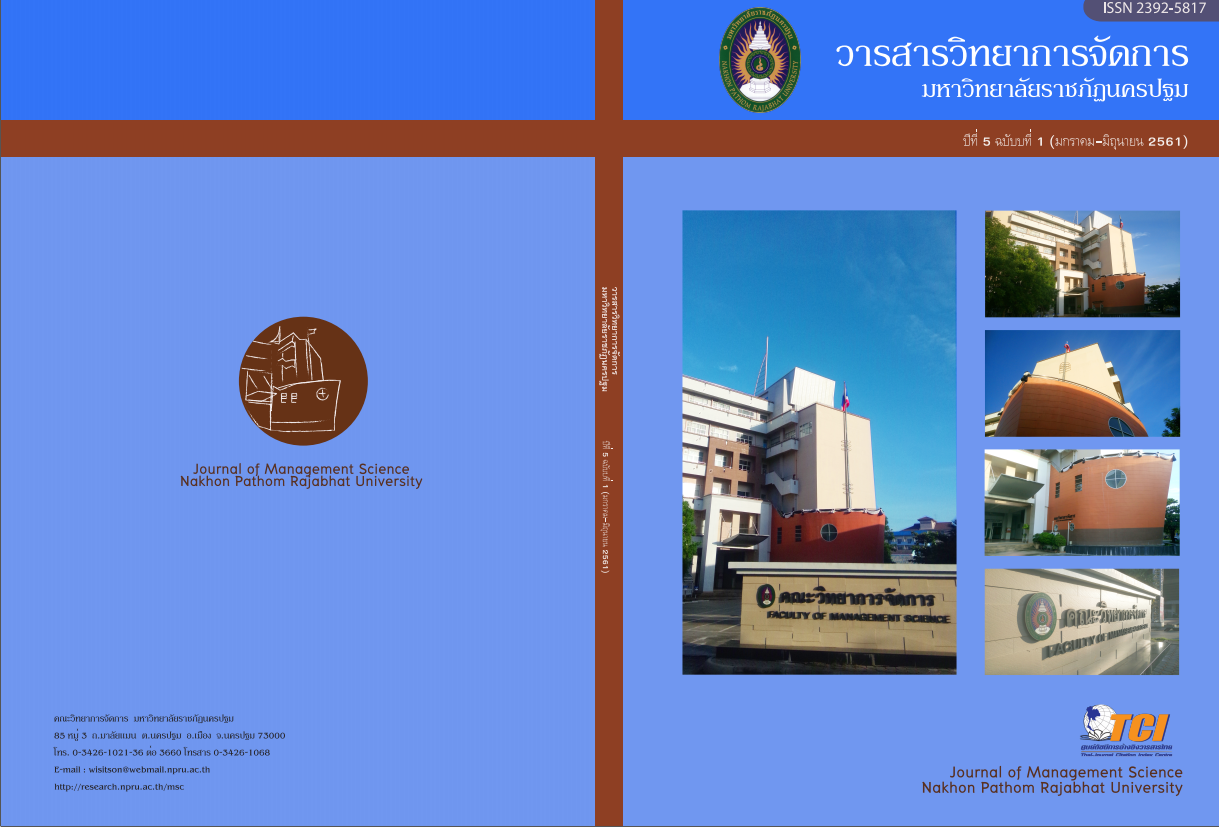Stress management in the workplace to maximize employee efficiency
Main Article Content
Abstract
The rapid changes in the world has been affected the way of life and influenced livings in society. It also creates the changes in economics which numerous organizations needs to improve and develop their personnel to meet the recent society demand. In addition, the factors encompassing with personal characteristics including gender, marital status and income; external organizational factors and internal organizational factors; economics and politics affected the stress of personnel which can then lead the decrease in work performance. With this, it is the duty of all organizations that need to manage the personnel’s stress from work in order that the personnel can increase the effectiveness and efficiency to meet the organizational goals. The personnel can confront the work stress by accepting the problems and using religiousness to hold the mind. Also, the organizations need to support, supervise, and be responsible for designing stress management, allow the personnel to participate into manipulating organizational goals, design job description for more interesting and motivated to work, promote more participation into organizational activities and conduct the Fitness and Wellness project with the aim of increasing and naturalizing the physical and mental strengths. Furthermore, the organizations establish the center to provide knowledge and manage the stress as well as to always organize the recreational and socialization activities. Hereinafter the personnel are satisfied and happy, they will be able to correctly manage their stress which then they can perform their work and task efficiently. Finally, this will result in the achievement of business operation.
Article history : Received 4 April 2018
Revised 15 May 2018
Accepted 18 May 2018
SIMILARITY INDEX = 5.24
Article Details
The views and opinions of the article appearing in this journal are those of the author. It is not considered a view and responsibility of the editorial staff.
References
จิระพร อุดมกิจ. (2547). ปัจจัยที่มีผลต่อความเครียดในการทำงานของบุคลากรคอมพิวเตอร์ในเขตกรุงเทพมหานคร. วิทยานิพนธ์ ศิลปศาสตร์มหาบัณฑิต. สาขาจิตวิทยาอุตสาหกรรมและองค์การ.มหาวิทยาลัยธรรมศาสตร์.
จำลอง ดิษยวณิช และพริ้มเพรา ดิษยวณิช. (2545). ความเครียด ความวิตกกังวล และสุขภาพ. เชียงใหม่ : ห้างหุ้นส่วนจำกัด เชียงใหม่โรงพิมพ์แสงศิลป์.
ฐาปนี วังกานนท์. (2556). ปัจจัยด้านการทำงานที่มีผลต่อความเครียดของพนักงาน : กรณีศึกษา บริษัท แอมพาส อินดัสตรี จำกัด. สารนิพนธ์ปริญญาบริหารธุรกิจมหาบัณฑิต. วิชาเอกการจัดการทั่วไป.บัณฑิตวิทยาลัย, มหาวิทยาลัยเทคโนโลยีราชมงคลธัญบุรี.
ณิธาฎา ปัญญาฟู. (2551). ความสัมพันธ์ระหว่างการรับรู้การทำงานหนักเกินไปกับความเครียดในงานของพนักงาน กรณีศึกษาพนักงานของ บริษัท บางกอกมีทบอล จำกัด. งานนิพนธ์ปริญญาศิลปะศาสตร มหาบัณฑิต. สาขาวิชาจิตวิทยาอุตสาหกรรมและองค์การ. คณะศิลปศาสตร์ประยุกต์. มหาวิทยาลัยเทคโนโลยีพระจอมเกล้าพระนครเหนือ.
ทศพล พาสุนันท์. (2551). การรับรู้การกำหนดเป้าหมายในการทำงานของพนักงานกับความเครียดในงานของพนักงาน. งานนิพนธ์ปริญญาศิลปศาสตรมหาบัณฑิต. สาขาวิชาจิตวิทยาอุตสาหกรรมและองค์การ. คณะศิลปศาสตร์ประยุกต์. มหาวิทยาลัยเทคโนโลยีพระจอมเกล้าพระนครเหนือ.
ธนวรรธ ตั้งสินทรัพย์. (2550). พฤติกรรมองค์การ. กรุงเทพฯ : ธนัชการพิมพ์.
ธัญรดา จิตสุรผล. (2553). แรงจูงใจ ความเครียด และพฤติกรรมการทำงานของพนักงานบริษัทประกันวินาศภัยในกรุงเทพมหานคร. สารนิพนธ์ปริญญาบริหารธุรกิจมหาบัณฑิต. สาขาวิชาการจัดการ. บัณฑิตวิทยาลัย. มหาวิทยาลัยศรีนครินทรวิโรฒ.
นงนุช สงวนสัตย์. (2557). ปัจจัยที่ส่งผลต่อความเครียดในการทำงานของพนักงานบัญชีบริษัทเอกชนในเขตกรุงเทพมหานคร. วิทยานิพนธ์ปริญญาบริหารธุรกิจมหาบัณฑิต. สาขาบริหารธุรกิจ. คณะบริหารธุรกิจ. มหาวิทยาลัยนานาชาติแสตมฟอร์ด.
ปรารถนา เล็กสมบูรณ์. (2554). ความเครียดในงาน การเผชิญปัญหา และความเหนื่อยหน่ายในงานของผู้ปฏิบัติการช่วยเหลือในสถานสงเคราะห์ของรัฐบาล : การวิจัยแบบผสานวิธี. วิทยานิพนธ์ปริญญาศิลปศาสตรมหาบัณฑิต. สาขาจิตวิทยาการปรึกษา. คณะจิตวิทยา. จุฬาลงกรณ์มหาวิทยาลัย.
พิมพ์ ศรีทองคำ. (2557). ความเครียดในการปฏิบัติงาน ภาวะผู้นำที่ส่งผลต่อประสิทธิภาพในการปฏิบัติงานของพนักงานปฏิบัติการในบริษัทเอกชนที่นำเข้าและจัดจาหน่ายสินค้าแฟชั่นแห่งหนึ่ง. สารนิพนธ์ปริญญาบริหารธุรกิจมหาบัณฑิต. สาขาบริหารธุรกิจ. บัณฑิตวิทยาลัย. มหาวิทยาลัยกรุงเทพ.
เพิ่มพร จิตตระชี. (2551). การวิเคราะห์องค์ประกอบท่ีส่งผลต่อความเครียดของโปรแกรมเมอร์โรงงานอุตสาหกรรมการส่งออกในเขตกรุงเทพมหานครและปริมณฑล. งานนิพนธ์ปริญญาศิลปศาสตรมหาบัณฑิต. สาขาวิชาจิตวิทยา. คณะศึกษาศาสตร์. มหาวิทยาลัยเทคโนโลยีพระจอมเกล้าธนบุรี.
สิริวิท อิสโร. (2550). ปัจจัยที่มีอิทธิพลต่อความเครียดในการปฏิบัติงานกรณีศึกษา : เจ้าหน้าที่ ควบคุมจราจรทางอากาศศูนย์ควบคุมจราจรทางอากาศบริษัทวิทยุการบินแห่งประเทศไทย. วิทยานิพนธ์รัฐประศาสนศาสตรมหาบัณฑิต. คณะรัฐศาสตร์. จุฬาลงกรณ์มหาวิทยาลัย.
สิริอร วิชชาวุธ. (2553). จิตวิทยาอุตสาหกรรมและองค์การเบื้องต้น. (พิมพ์ครั้งที่ 3). กรุงเทพฯ : สำนักพิมพ์มหาวิทยาลัยธรรมศาสตร์.
สุพานี สฤษฎ์วานิช. (2552). พฤติกรรมองค์การสมัยใหม่: แนวคิดและทฤษฎี. ปทุมธานี : มหาวิทยาลัยธรรมศาสตร์.
อนันท์ งามสะอาด. (2551). ประสิทธิภาพและประสิทธิผลต่างกันอย่างไร. [ออนไลน์].ค้นเมื่อ 1 มีนาคม 2560 จาก https://www.kat.ac.th/index.php/81-2011-12-30-02-36-17/2584-28aaa.
อดิศร พูลสุวรรณ. (2552). ความสัมพันธ์ระหว่างสภาพแวดล้อมในการทำงานและการรับรู้ความเสี่ยงกับความเครียดในการทำงานกรณีศึกษา : พนักงานฝ่ายผลิตบริษัท ฮิตาชิ โกลบอล สตอเรจเทคโนโลยีส์ (ประเทศไทย) จำกัด. งานนิพนธ์ปริญญาศิลปศาสตรมหาบัณฑิต. สาขาวิชาจิตวิทยาอุตสาหกรรมและองค์การ. คณะศิลปศาสตร์ประยุกต์.มหาวิทยาลัยเทคโนโลยีพระจอมเกล้าพระนครเหนือ.
อภิญญา วิเวโก. (2549). ปัจจัยด้านงาน ความเครียด และประสิทธิภาพการปฏิบัติงานของ พนักงานในกรุงเทพมหานคร. วิทยานิพนธ์ปริญญาบริหารธุรกิจมหาบัณฑิต. สาขาการจัดการ.บัณฑิตวิทยาลัย.มหาวิทยาลัยศรีนครินทรวิโรฒ.
อาภรณ์ ภู่วิทยาพันธ์.(2542). ความสัมพันธ์ระหว่างมโนทัศน์เกี่ยวกับตนเองในการทำงานและระดับความเครียดที่เกิดจากการทำงานของผู้ใหญ่วัยตอนต้นและผู้ใหญ่วัยตอนกลาง กรณีศึกษา : พนักงานปฏิบัติงานในรัฐวิสาหกิจชั้นดีสำนักงานใหญ่. วิทยานิพนธ์ศิลปศาสตรมหาบัณฑิต. สาขาจิตวิทยาอุตสาหกรรมและองค์การ. คณะศิลปศาสตร์.มหาวิทยาลัยธรรมศาสตร์.
Anderson, C. A., & Dill, K. E. (2000). Video games and aggressive thoughts, feelings, and behavior in the laboratory and in life. Journal of Personality and Social Psychology, 78 (4) : 772-790.
Chikako Ogiwara; et al. (2008). Gender-related Stress among Japanese Working Women. Transcult Psychiatry, 45 (3). Retrieved Februarys 25, 2018, from https://tps.sagepub.com/cgi/ content/ abstract/45/3/470 ().
Hilary Jones. (1997). I’m Too Busy To Be Stressed. London : Hoddes and Stoughton.
Ivancevich, J. M., & Matteson, M. T. (1980). Optimizing human resources: A case for preventive health and stress management. Organizational Dynamics, Organizational Dynamics, 9, 5-25. https://doi.org/10.1016/0090-2616(80)90037-6.
Morris CG. (1990). Psychology: An introduction. (7th ed.). Englewood Cliffs, New Jersey : Presentice-Hall, Inc.
Parker, D. F., & Decotiis, T. A. (1983). Organizational determinants of job stress. Organizational Behavior and Human Performance, 32, 160-177.
Selye, H. (1983). Selye’s guide to stress research. New York : Van Northland Reinhold.
Stephen P. Robins & Timothy A. Judge. (2017). Organizational Behavior. (17th ed.). Essex : Pearson Education Limited.
Wilmar B. Schaufeli; & Michiel A. J. Kompier. (2001). Managing Job Stress in the Netherlands. International Journal of Stress Management, 8,(1) Retrieved Februarys 25, 2018, from https://www.springerlink.com/content/k078831100g46811/?p=0465abfdc378413 f59c890 ca&pi=1.


